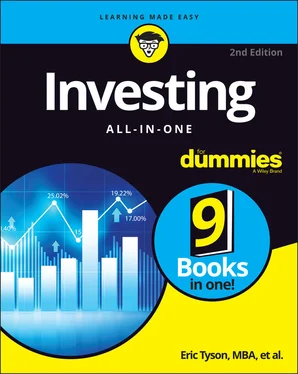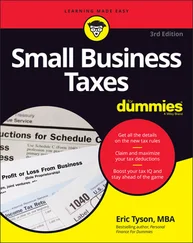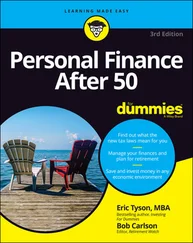Eric Tyson - Investing All-in-One For Dummies
Здесь есть возможность читать онлайн «Eric Tyson - Investing All-in-One For Dummies» — ознакомительный отрывок электронной книги совершенно бесплатно, а после прочтения отрывка купить полную версию. В некоторых случаях можно слушать аудио, скачать через торрент в формате fb2 и присутствует краткое содержание. Жанр: unrecognised, на английском языке. Описание произведения, (предисловие) а так же отзывы посетителей доступны на портале библиотеки ЛибКат.
- Название:Investing All-in-One For Dummies
- Автор:
- Жанр:
- Год:неизвестен
- ISBN:нет данных
- Рейтинг книги:3 / 5. Голосов: 1
-
Избранное:Добавить в избранное
- Отзывы:
-
Ваша оценка:
- 60
- 1
- 2
- 3
- 4
- 5
Investing All-in-One For Dummies: краткое содержание, описание и аннотация
Предлагаем к чтению аннотацию, описание, краткое содержание или предисловие (зависит от того, что написал сам автор книги «Investing All-in-One For Dummies»). Если вы не нашли необходимую информацию о книге — напишите в комментариях, мы постараемся отыскать её.
Investing All-in-One For Dummies
.
Dummies
Investing All-in-One For Dummies
Investing All-in-One For Dummies
Investing All-in-One For Dummies — читать онлайн ознакомительный отрывок
Ниже представлен текст книги, разбитый по страницам. Система сохранения места последней прочитанной страницы, позволяет с удобством читать онлайн бесплатно книгу «Investing All-in-One For Dummies», без необходимости каждый раз заново искать на чём Вы остановились. Поставьте закладку, и сможете в любой момент перейти на страницу, на которой закончили чтение.
Интервал:
Закладка:
If you don’t know how to evaluate and reduce your spending or haven’t thought about your retirement goals, looked into what you can expect from Social Security, or calculated how much you should save for retirement, now’s the time to do so. Pick up the latest edition of Personal Finance in Your 20s & 30s For Dummies by Eric Tyson, MBA (Wiley) to find out all the necessary details for retirement planning and much more.
Investing regularly with dollar cost averaging
Regularly investing money at set time intervals, such as monthly or quarterly, in volatile investments such as stocks, stock mutual funds, or exchange-traded funds is called dollar cost averaging (DCA). If you’ve ever had money regularly deducted from your paycheck and contributed to a retirement savings plan investment account, you’ve done DCA.
Most folks invest a portion of their employment compensation as they earn it, but if you have extra cash sitting around, you can choose to invest that money in one fell swoop or to invest it gradually via DCA. The biggest appeal of gradually feeding money into the market via DCA is that you don’t dump all your money into a potentially overheated investment just before a major drop. No one has a crystal ball and can predict which direction investments will move next in the short term. DCA helps shy investors psychologically ease into riskier investments.
DCA is made to order for skittish investors with larger lump sums of money sitting in safe investments like bank accounts. It also makes sense for investors with a large chunk of their net worth in cash who want to minimize the risk of transferring that cash to riskier investments, such as stocks.
As with any risk-reducing investment strategy, DCA has its drawbacks. If growth investments appreciate (as they’re supposed to over time), a DCA investor misses out on earning higher returns on his money awaiting investment. Studying U.S. stock market data over seven decades, finance professors Richard E. Williams and Peter W. Bacon found that approximately two-thirds of the time, a lump-sum stock market investor earned higher first-year returns than an investor who fed the money in monthly over the first year.
However, knowing that you’ll probably be ahead most of the time if you dump a lump sum into the stock market is little consolation if you happen to invest just before a major drop in prices. For example, from late 2007 to early 2009, global stocks shed about half of their value. And how about those who invested in stocks in late 2019 and early 2020 only to see stocks slide by more than one-third in just a matter of weeks in March of 2020 due to the government-mandated economic shutdowns resulting from the COVID-19 pandemic?
If you use DCA too quickly, you may not give the market sufficient time for a correction to unfold, during and after which some of the DCA purchases may take place. If you practice DCA over too long a period of time, you may miss a major upswing in stock prices. Consider using DCA over one to two years to strike a balance. Alternatively, if you’re comfortable with the risk, get your money invested and get on with your life!
 When you use DCA, establish an automatic investment plan so you’re less likely to wimp out of your strategy. Your money that awaits investment in DCA should have a suitable parking place. Consider a money market fund that’s appropriate for your tax situation.
When you use DCA, establish an automatic investment plan so you’re less likely to wimp out of your strategy. Your money that awaits investment in DCA should have a suitable parking place. Consider a money market fund that’s appropriate for your tax situation.
Knowing the Impact of Investing for College Costs
Many well-intentioned parents want to save for their children’s future educational expenses. The mistake that they often make, however, is putting money in accounts in the child’s name (in so-called custodial accounts) or saving outside retirement accounts in general. The more money you accumulate outside tax-sheltered retirement accounts, the more you will generally end up paying for college costs.
 Under the current financial needs analysis used by most colleges and universities in awarding “financial aid” (that is, how much of their very high sticker price they will charge you), the value of your retirement plan is not considered to be an asset. Money that you save outside retirement accounts, including money in the child’s name, is counted as an asset and reduces eligibility for financial aid.
Under the current financial needs analysis used by most colleges and universities in awarding “financial aid” (that is, how much of their very high sticker price they will charge you), the value of your retirement plan is not considered to be an asset. Money that you save outside retirement accounts, including money in the child’s name, is counted as an asset and reduces eligibility for financial aid.
Also, be aware that your family’s assets, for purposes of financial aid determination, generally include equity in real estate and businesses you own. Although the federal financial aid analysis no longer counts equity in your home as an asset, many private (independent) schools continue to ask parents for this information when they make their own financial aid determinations. Thus, paying down your home mortgage more quickly instead of funding retirement accounts can harm you financially. You may end up paying more for college costs and pay more in taxes.
 Make it a priority to contribute to your retirement savings plan(s). If you instead save money in a nonretirement account for your children’s college expenses, you will pay higher taxes both on your current income and on the interest and growth of this money. In addition to paying higher taxes, you’ll be expected to pay a higher price for your child’s educational expenses.
Make it a priority to contribute to your retirement savings plan(s). If you instead save money in a nonretirement account for your children’s college expenses, you will pay higher taxes both on your current income and on the interest and growth of this money. In addition to paying higher taxes, you’ll be expected to pay a higher price for your child’s educational expenses.
Paying for college
If the way in which the financial aid system works effectively encourages you to save in your own retirement accounts, how will you pay for your kid’s education expenses? Here are some ideas and resources:
Home equity: You can borrow against your home at a relatively low interest rate, and the interest is generally tax-deductible.
Company retirement plans: Some 401(k)s allow borrowing for educational costs.
Student loans: Several financial aid programs allow you to borrow at reasonable interest rates. The Unsubsidized Stafford Loans and Parent Loans for Undergraduate Students (PLUS), for example, are available, even when your family isn’t deemed financially needy.
Grants and scholarships: Grant programs are available through schools and the government, as well as through independent sources. Complete the Free Application for Federal Student Aid (FAFSA) application to apply for the federal government programs. Grants available through state government programs may require a separate application. Specific colleges and other private organizations — including employers, banks, credit unions, and community groups — also offer grants and scholarships.
Work and save: Your child can work and save money during high school and college. In fact, if your child qualifies for financial aid, they’re generally expected to contribute a certain amount to education costs from employment (both during the school year and summer breaks) and from savings. Besides giving your teen a stake in their own future, this training encourages sound personal financial management down the road.
No one enjoys filling out financial aid forms. It’s difficult, intimidating, invasive, and stressful. Yet it’s a necessary step many families must take in order to make college more affordable. First, let’s clear up a major misconception: Receiving financial aid doesn’t actually mean you receive money for college. Rather it means they charge different customers widely differing prices based upon the college’s assessment of your ability to pay. Your goal is to position your finances to receive more favorable pricing. And doing that is not as hard as it may seem. Here are some tips:
Читать дальшеИнтервал:
Закладка:
Похожие книги на «Investing All-in-One For Dummies»
Представляем Вашему вниманию похожие книги на «Investing All-in-One For Dummies» списком для выбора. Мы отобрали схожую по названию и смыслу литературу в надежде предоставить читателям больше вариантов отыскать новые, интересные, ещё непрочитанные произведения.
Обсуждение, отзывы о книге «Investing All-in-One For Dummies» и просто собственные мнения читателей. Оставьте ваши комментарии, напишите, что Вы думаете о произведении, его смысле или главных героях. Укажите что конкретно понравилось, а что нет, и почему Вы так считаете.












